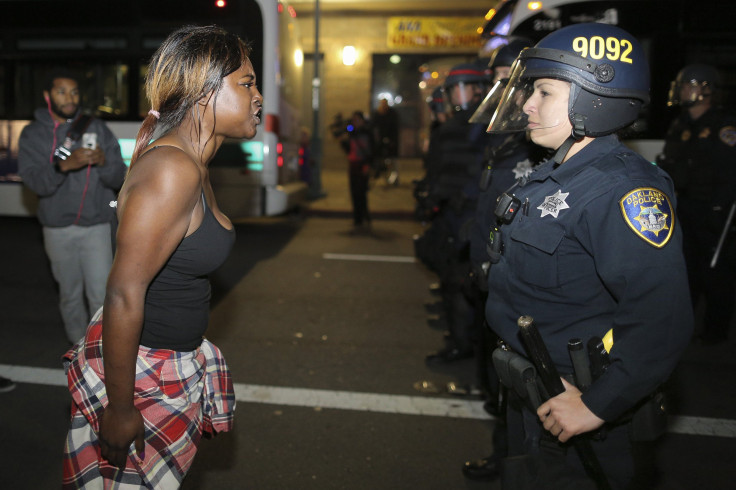Ferguson Protests: 5 Ways Research Supports Claim Of Racial Bias In US Criminal Justice System

A Missouri grand jury’s decision not to indict white police officer Darren Wilson for black teenager Michael Brown’s death did not shock many black Americans, who said the ruling typified a criminal justice system that unfairly targets black people. The feeling that law enforcement treats black Americans differently from whites is a familiar message among protesters in Ferguson and across the country whose slogan, “No Justice, No Peace,” is about much more than the killing of one black teenager.
“You aren’t giving us justice,” one Ferguson demonstrator recently shouted at police, according to the Independent. “We’re animals – that’s what you think! But we’re Americans, just like you!”
Brown’s death sparked anew a national debate about what it means to be black in America, where those in charge of enforcing the laws often differ from the people they police. Experts have said one of the biggest disparities in American law enforcement is the racial makeup of the country’s police forces. Three-quarters of U.S. cities have higher percentages of white officers than white residents, research found. Twenty-nine cities surveyed had five times the percentage of white officers as white residents.
Numbers like this have led many to criticize the U.S. justice system as skewed against black Americans. Although it has been nearly 50 years since the final days of Jim Crow laws, the effects of segregation linger, and many black Americans feel that the cards are still stacked against them. “The United States of America is not for black people,” Deadspin writer Greg Howard boldly stated in August. “What’s happening in Ferguson is about so many second-order issues — systemic racism, the militarization of police work, and how citizens can redress grievances, among other things.”
Here is some of the evidence that supports that claim:
Black Americans are disproportionately represented in prison populations. In 2013, almost 3 percent of black males in the U.S. were in state or federal prison, a rate six times higher than for white U.S. males, according to the U.S. Department of Justice. Black males had higher incarceration rates across all age groups than any other race. Black women were twice as likely to be imprisoned that year as white women, the department found.
In general, “racial minorities are more likely than white Americans to be arrested,” according to a report published this year from Washington, D.C.-based group the Sentencing Project. The study also noted that “once arrested, [minorities] are more likely to be convicted; and once convicted, they are more likely to face stiff sentences.” Shockingly, the report predicted that one-third of black males born today in the U.S. will go to prison at some point in their lives.
White Americans believe black Americans commit more crimes than they actually do. The same Sentencing Project report found that people overestimate the proportion of crime committed by people of color. White respondents to a 2010 crime survey estimated black Americans’ share of burglaries, illegal drug sales and juvenile crime to be between 20 and 30 percent higher than it actually was.
The evidence supports claims that white Americans “associate blacks and Latinos with criminality,” the report said, and that those perceptions continue to be a “driving force of criminal justice outcomes.”
More blacks go to prison for the same crimes that whites commit. Despite illegal drug use being about twice as prevalent among white Americans overall, blacks are more than three times as likely to go to prison for drug possession than whites, according to a Human Rights Watch report from 2009. About twice as many whites have used cocaine compared to blacks, and higher percentages of whites have tried pain relievers (used illicitly), methamphetamines and hallucinogens.
Even though blacks and whites use and sell marijuana at about the same rates, black Americans are arrested at far higher rates for marijuana-related offenses than whites. In 2010, blacks were roughly 2.5 times more likely to be detained for marijuana possession than whites, according to the Washington Post.
The justice system judges black lawbreakers more harshly than white lawbreakers. Prison sentences for black men are nearly 20 percent longer than for white men for committing similar crimes, according to the U.S. Sentencing Commission. In a 2005 report on racial disparity in sentencing, the commission found that “young black and Latino males … are subject to particularly harsh sentencing compared to other offender populations.” The study also noted that black defendants face harsher penalties for harming white victims than white defendants who harm whites.
“Black and Latino defendants tend to be sentenced more severely than comparably situated white defendants for less serious crimes, especially drug and property crimes,” the report concluded.
Black schoolchildren are disciplined more harshly than white students for similar offenses. Nationwide, one in five black males and more than one in 10 black females were suspended in 2009 and 2010, more than any other race, according to the U.S. Department of Education’s Civil Rights Data Collection. Other research has shown that in a survey of 72,000 U.S. schools, black students made up only about 18 percent of those enrolled, but accounted for 35 percent of one-time suspensions and 46 percent of those suspended more than once. They also accounted for 39 percent of all expulsions, according to the Kirwan Institute.
© Copyright IBTimes 2024. All rights reserved.






















